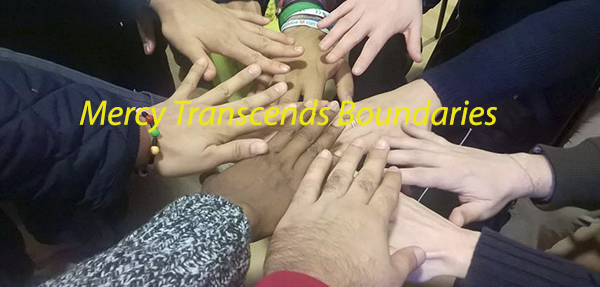Jesus and the Canaanite Woman (Mt 15,21-28)
The healing of the daughter of the Canaanite woman is a fascinating narrative where the divine mercy and the persevering faith cross paths and converge at the end, resulting in a healing. The puzzling account of the Canaanite woman’s faith occurs in the narrative block of 13,54-17,27 that deals with “faith in Jesus”. The message of the kingdom, proclaimed in the Parable Discourse (13,1-53) is subsequently met with threefold human response: rejection, misunderstanding and faith (wavering faith, little faith, and deep faith).
Prior to the exchange between Jesus and this Gentile woman, there are episodes of the wavering faith of Peter in 14,28-31, rejection of Jesus by the Pharisees and the scribes (15,1-9) and misunderstanding by the Pharisees concerning the purity laws that separate clean from unclean and Jew from Gentile (15,10-20). Further, the present episode is followed by rejection of Jesus (16,1-4) and misunderstanding by the disciples (16,5-12). So, in the midst of this narrative tension, Matthew presents the Canaanite woman as a model for faith, who seeks mercy and help on behalf of her severely demon possessed daughter.
The Canaanite woman lives at the ‘boundaries’. In fact, the entire episode is punctuated by ‘boundaries’ – geographical, ethnic, racial, cultural, gender, social and religious, which heighten the intensity of the exchange between the two primary characters—Jesus and the Canaanite woman.
1. Geographical and Ethnic Boundaries: The narrative begins with the spatial setting that contains the detail of Jesus’ withdrawal to the region of Tyre and Sidon, the two Gentile cities on the Mediterranean coast. Earlier in the gospel, these two Phoenician cities were presented in contrast to Chorazin and Bethsaida in the woes of the unrepentant cities (11,21-22). Even in the OT, both these cities shared the infamous reputation (cf. Isa 23,1-18, Ezek 26—28; Joel 3,4-8) for their arrogance of wealth and power. Secondly, the specific reference to the ethnicity of the woman as a Canaanite (unlike Mark who identifies her as a Syrophonecian by birth in 7,24-30), recalls the OT image of the traditional enemy of Israel. This precise reference to the woman as ‘Canaanite’, the ancient designation of the pagan inhabitants of that area, sets the tone for an encounter between a Jew and a Gentile and also a theological concern of Matthean community, regarding their relationship in God’s plan of salvation. The word ‘Canaanite’ is used only here in Mt (never in other gospels), who perhaps intentionally chose this term to draw readers’ attention to the ‘otherness’ of the woman that distinguished her from the rest of the characters in the story. We might ask—who actually crossed the boundaries? Jesus or the Canaanite woman? Did Jesus really go to the gentile cities or did the woman cross over to the Jewish soil? The Greek text poses some ambiguous details. However, the inconsistent geographical problem matters less considering the entire narrative, since the focus shifts to the encounter between Jesus and the Canaanite woman.
2. Gender Boundaries: Presented as ‘woman’ in addition to being ‘gentile’, the role of the Canaanite woman seems to be further marginalized. “Send her away, for she is crying after us”—the reaction of the disciples to the plea of the woman can either be sensitive or indifferent. Taken in a positive sense, the suggestion of the disciples can be interpreted as “do something for her and send her away” or negatively, “get rid of her, for she keeps shouting after us”. Previously, in Mt 14,15 the disciples had asked Jesus to ‘send away’ the crowd to buy food before it got too late. But Jesus resisted their request and in contrast, fed the crowds with the loaves and fish. In the intervention of the disciples, either one of indifference or of suggestion to help the woman, the distinction of ‘we’ and ‘she’; ‘us’ and ‘her’ is clearly evident in their address. She being a ‘woman’ and a ‘gentile’ is obviously an ‘outsider’ to the group, whose presence has to be got rid of at the earliest.
3. Theological Boundaries: Following Jesus’ enigmatic silence and disciples’ reaction, the exclusivist reply of Jesus to the woman raises eyebrows. “I was sent only to the lost sheep of the house of Israel” is certainly a theological justification for Jesus’ mission exclusively for the Jewish people. Previously, a similar saying in Mt 10,5-6 was part of the instruction to the disciples for the mission, “Go nowhere among the Gentiles… but go rather to the lost sheep of Israel.” In the light of Ezek 34,16, the restoration of the ‘lost sheep’ was an important mission of the Messiah—to seek the lost, to bring back the strayed, to bind up the crippled and to strengthen the weak. Further, from Mt’s theological perspective, before offering salvation to the Gentiles, God in Christ offered salvation to Israel. As a result, Jesus’ mission is presented as a fulfillment of the OT promises. However, Jesus’ reply certainly leaves an open-ended tension between ‘particularism’ and ‘universalism’ (Jewish Mission and Gentile Mission).
4. Social and Religious Boundaries: The repeated request of the Canaanite woman for help certainly receives a harsh response from Jesus—“it is not good to take the children’s food and throw it to the dogs.” Understood allegorically, the ‘children’ refers to the Israelites and ‘dogs’ to the Gentiles. In fact, this statement has led to much debate and discussion among the scholars as to why did Jesus use such a derogatory or crude analogy to refer to a group of people? Most likely, it is a household image, where children receive food from their parents and dogs from their masters. The point of the argument is that both do not receive the same food. However, in no way, it was meant to compare the two subjects—children and dogs at an ontological level. If this household imagery were to be taken out of the domestic context and applied to the existing social tensions between Jews and Gentiles, we might miss the point as well. No one can deny the prevalent social enmity between Jews and Gentiles. However, the purpose of the analogy was not meant to highlight the sensitive relations between these two groups, but to accentuate the ‘blessing’ and the ‘privilege’ that the Jewish people as God’s chosen nation received. As a result, one can also find the implied exclusivist concept of mission and salvation here. In spite of being rejected, as a response, the woman shows her firm faith by using the same analogy affirming that she can still be a recipient of God’s blessings, even though she belongs to the ‘other’ group. Thus, the social and religious ‘other’ can still find entry into the kingdom of heaven and be recipients of his blessings, if they persist in faith.
5. Transcending All Boundaries: “Have mercy on me, Lord, Son of David”, “Lord, help me”. Despite the continual rejections, the woman perseveres in pleading for mercy. Importantly, three times she continues to address him as “Lord” acknowledging his messiahship. “Have mercy on me”—to the Lord of mercy, the woman pleads for mercy. Here, Mt uses the word eleew for mercy. On five occasions in Mt’s gospel, Jesus appears as the subject of this verb of mercy (9,27; 15,22; 17,15; 20,30-31). And all the five occurrences are in the context of healing—either the sick persons or their relatives approach Jesus with an appeal to have mercy. In turn, Jesus accepts their request and heals them. In fact, all the healing miracles of Jesus, from this perspective, can be seen as divine expressions of mercy. One of the ways that the biblical concept of mercy is understood is in terms of kindness, shown to the person who is in dire need. This is clearly reflected in the cry of this gentile mother, who pleads Jesus to have kindness shown to her and to her daughter. And the mercy that she pleaded from Jesus is shown to her finally with an appreciation for her enduring faith, “O woman, great is your faith! Be it done for you as you desire” (v.28). As the story ends, all the boundaries are transcended; faith wins over tradition and beliefs. Ultimately, faith triumphs and mercy prevails!
Finally, what does this biblical story convey to us? a) God shows mercy and kindness to those who are in need. His mercy works beyond boundaries. All boundaries are human constructions, defined and set up by human thinking and legitimized by human institutions that have the potential to enslave the ‘other’. However, they cannot limit God and his mercy; b) A marginalized person, who lives at the boundaries is presented as a model for faith in order to emphasize that God’s mercy reaches even to the periphery; c) God’s reign is for everyone – Jews and Gentiles, men and women, insiders and outsiders, pure and impure. No one is excluded from the blessings that the reign of God brings, even those who live at the periphery. Hence, it is an invitation to examine one’s attitudes, traditions and beliefs that tend to marginalize people on the basis of race, gender, ethnicity, religion, class, nationality etc. and d) finally, the narrative of the Canaanite woman is a story of the enduring struggle of persevering faith. One’s ethnicity or religious tradition is not a hindrance to anyone, who has faith in Jesus to be accepted by him. No doubt, in Mt’s gospel this pagan mother stands as an icon of unwavering faith in contrast with the people of Jesus’ hometown who reject him (13,54-58), and even in contrast with the disciples, who vacillate between deep faith and little faith (14,30-31). One who has deep faith and is in great need, God cannot but be merciful.
Fr. Naveen, SVD.










